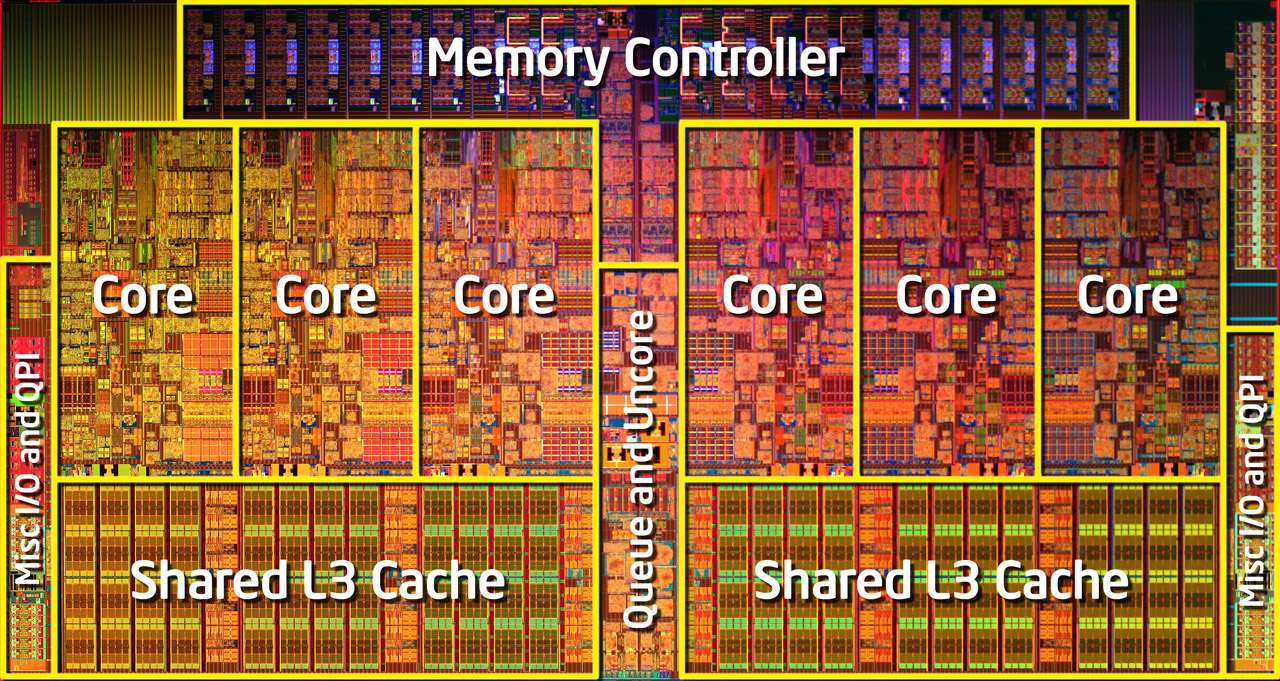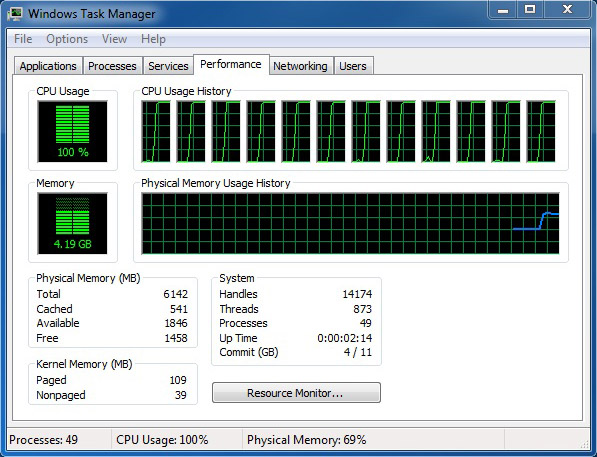The Intel Core i7-990X Extreme Edition Processor Review
We were impressed enough with Intel’s Sandy Bridge architecture that we awarded the Core i5-2500K our coveted Recommended Buy award. Just north of $200, that’s a solid value. But it’s not Intel’s flagship. That honor goes to the new Core i7-990X Extreme.
Stepping Back In Time For A New Champion
The Core i7-990X is a simply evolution of Intel’s six-core Gulftown design. It’s exactly the same architecturally—right down to family, model, stepping, and revision. These chips are binned higher to guarantee their stability at a base clock rate of 3.46 GHz and a maximum Turbo Boosted frequency of 3.73 GHz (when a single thread is active).
| Intel Core i7 Lineup (February 20, 2011 Price List) on www.intc.com | |||||||
|---|---|---|---|---|---|---|---|
| Row 0 - Cell 0 | LGA Interface | Base Clock | Max Clock | Cores/Threads | L3 Cache | TDP | Price |
| Core i7-990X | LGA 1366 | 3.46 GHz | 3.73 GHz | 6/12 | 12 MB | 130 W | $999 |
| Core i7-980X | LGA 1366 | 3.33 GHz | 3.6 GHz | 6/12 | 12 MB | 130 W | $999 |
| Core i7-970 | LGA 1366 | 3.2 GHz | 3.46 GHz | 6/12 | 12 MB | 130 W | $583 |
| Core i7-2600K | LGA 1155 | 3.4 GHz | 3.8 GHz | 4/8 | 8 MB | 95 W | $317 |
| Core i7-2600 | LGA 1155 | 3.4 GHz | 3.8 GHz | 4/8 | 8 MB | 95 W | $294 |
| Core i7-960 | LGA 1366 | 3.2 GHz | 3.46 GHz | 4/8 | 8 MB | 130 W | $294 |
| Core i7-950 | LGA 1366 | 3.06 GHz | 3.33 GHz | 4/8 | 8 MB | 130 W | $294 |
| Core i7-880 | LGA 1156 | 3.06 GHz | 3.73 GHz | 4/8 | 8 MB | 95 W | $583 |
| Core i7-875K | LGA 1156 | 2.93 GHz | 3.6 GHz | 4/8 | 8 MB | 95 W | $342 |
| Core i7-870 | LGA 1156 | 2.93 GHz | 3.6 GHz | 4/8 | 8 MB | 95 W | $294 |
| Core i7-860 | LGA 1156 | 2.8 GHz | 3.46 GHz | 4/8 | 8 MB | 95 W | $284 |
Though I’m sure you’re amply familiar with Intel’s Gulftown design and its underlying architecture, here’s a quick recap from Intel Core i7-980X Extreme: Hello, Six-Core Computing, remixed for today's review:
“Of course, Gulftown is enabled by Intel’s 32 nm manufacturing process—the same node we saw debut back in January of 2010 with the Clarkdale and Arrandale processor families. This time, however, enthusiasts don’t have to be bamboozled by a second, on-package 45 nm die handling graphics, memory control, and PCI Express connectivity. The Core i7-990X gets us performance-freaks back to where we want to be—on-die memory controller, PCI Express handled by the well-endowed X58 chipset, and discrete graphics only, please.
With Gulftown, Intel uses its 32 nm process to add cores and cache, rather than push integration. As a result, we have a six-core processor with 12 MB of shared L3 cache. Architecturally, Gulftown is otherwise the same as Bloomfield. Each core gets 32 KB of L1 instruction cache, 32 KB of L1 data cache, and a dedicated 256 KB L2 cache.
The 12 MB shared L3 actually is a potential performance-booster. Because the cache can be dynamically allocated, an application that only utilizes one core can conceptually monopolize the entire cache. According to Intel, there are some gains to be had in gaming, for example, but it’ll be difficult to gauge just how much of the speed-up we see comes from increased core count versus cache, particularly since we’re using very few single-threaded benchmarks any more.
Despite the addition of two cores and 4 MB of L3, Gulftown employs a smaller die than its predecessor (248 square millimeters versus Bloomfield’s 263). Transistor count increases from 731 million to 1.17 billion. That’s fairly incredible, considering the Core i7-990X fits within the same 130 W thermal envelope as existing Core i7-900-series processors.
Gulftown’s memory controller remains unchanged, still rated for three channels of DDR3-1066 memory. This is actually somewhat interesting, since the 130 W Westmere-EP processors support DDR3-1333 (and with up to two modules per channel, no less). Nevertheless, we should see similar memory performance, as Bloomfield’s four cores clearly weren’t starved for data anyway.
Get Tom's Hardware's best news and in-depth reviews, straight to your inbox.
The other addition worth noting is AES-NI, Intel’s hardware-based instructions for accelerating the cryptography standard. Previously seen only in the company’s Clarkdale-based Core i5s (and unfortunately left out of the other Clarkdales), AES-NI isn’t yet having a massive effect on performance. But as we’ll see in the benchmarks, there’s a ton of potential there.”
Current page: Stepping Back In Time For A New Champion
Prev Page Core i7-990X: Fast Enough To Be The New King? Next Page Test Setup And Benchmarks-
binoyski Darn, the contest should be open to all Tom's Hardware registered users even from a different country!Reply -
Saljen My friend just built a new gaming rig with the 980x as the processor... He plays Age of Conan. I busted up laughing when he said he spent $1k on a processor that he'll only use to 1/10th of its potential. Told him he should have gotten an i5, now I'll send him this article as further proof.Reply -
HansVonOhain This is just a ripoff by intel on those who are not knowledgeable enough that more expensive does not always mean better.Reply -
adamboy64 Well, some people just want the best when they buy a PC, regardless of cost efficiency, can't blame 'em. There'll always be that market.Reply -
cangelini binoyskiDarn, the contest should be open to all Tom's Hardware registered users even from a different country!Reply
Really wish it could be binoyski. We have specific tax laws, unfortunately, that prevent it. Same reason the folks in RI can't enter :-/ -
joytech22 Wow AMD's CPU is just getting plain-ol decimated in this review.Reply
Still, it does hold it's ground even though the architecture is like 4 years old, using the same technology that was around back when the C2Q's we're the high-end (the same as the original phenoms on a die shrink).
Because of this, I can almost guarantee AMD's success with their future CPU's, just like I predicted the 2600K would be faster in most cases than the 980X.
That doesn't mean I'm saying that Bulldozer will outperform the i7's or upcoming 8-core Intel CPU's I'm just saying that there's going to be some serious decisions for upgraders this year.
I mean look at Magny corus 12 core (2.2GHz) vs i7 980x, it's almost as fast and 1GHz slower (but 12 physical cores) and cost's the same.
-
iam2thecrowe joytech22Wow AMD's CPU is just getting plain-ol decimated in this review.i wouldnt say decimated, and its cheaper also. That benchmark of metro 2033 is interesting, particularly the better lowfps the AMD chip managed. But i agree they have flogged this horse as far as it will go and they need bulldozer ASAP to be competitive.Reply -
haplo602 HansVonOhainThis is just a ripoff by intel on those who are not knowledgeable enough that more expensive does not always mean better.Reply
I thought that's what Intel is doing with all of their CPUs :-)


